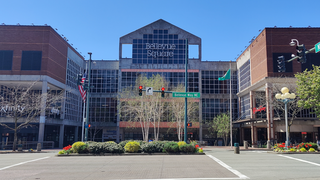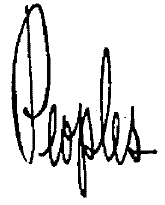
Henry Morgan & Company was a Canadian department store chain founded by Henry Morgan in 1845. The first store was in Montreal, and expanded to include 11 stores in Ontario and Quebec before being bought by Hudson's Bay Company in 1960. The stores in Ontario were converted to Hudson's Bay Company stores that year and renamed The Bay in 1965; the remaining Morgan's stores in Quebec were renamed La Baie in 1972.

Bellevue Square is a shopping center in Bellevue, Washington. The mall has over 200 retail stores with anchors Macy's and Nordstrom. Bellevue Square also offers concierge services, valet parking, and a children's play area. It and the connecting Lincoln Square comprise The Bellevue Collection.

Eaton Centre is a name associated with shopping centres in Canada, originating with Eaton's, one of Canada's largest department store chains at the time that these malls were developed. Eaton's partnered with development companies throughout the 1970s and 1980s to develop downtown shopping malls in cities across Canada. Each mall contained an Eaton's store, or was in close proximity to an Eaton's store, and typically the mall itself carried the "Eaton Centre" name. These joint ventures were a significant retail development trend in Canada during that period.

Westlake Center is a four-story shopping center and 25-story office tower in downtown Seattle, Washington, United States. The southern terminus of the Seattle Center Monorail, it is located across Pine Street from Westlake Park, between 4th and 5th Avenues. It is named for Westlake Avenue, which now terminates north of the mall but once ran two blocks farther south to Pike Street. Westlake Park is considered Seattle's "town square" and celebrities and political figures often make appearances or give speeches from the building's balcony. The anchor stores are Saks Off 5th and Nordstrom Rack.
Miller & Rhoads was a Virginia-based department store chain. Throughout its 105-year lifespan, the store played an active role in the Richmond, Virginia community, along with its friendly cross-street rival Thalhimers. The Richmond flagship location was known for its "SantaLand" upstairs attraction, which has since become an attraction at the Children’s Museum of Richmond. Following a series of ownership changes starting in 1967, Campeau Corporation purchased Miller & Rhoads in 1987 and later sold it to Philadelphia developer Kevin Donohoe and store management before closing in 1990.
Lamonts was a chain of department stores founded in Seattle, Washington. The chain was started in 1970 when Pay 'n Save renamed its suburban branches of Rhodes, a department store chain the company acquired in 1965. Lamonts remained a division of Pay 'n Save until 1985. During the 1990s, the chain filed for bankruptcy twice and closed several stores before being sold to Gottschalks in 2000. Gottschalks itself went into bankruptcy and liquidated in 2009.

Westfield Southcenter, formerly known as Southcenter Mall, is a shopping mall located in Tukwila, Washington, United States. Owned by Unibail-Rodamco-Westfield, it is the largest shopping center in Washington state and the Pacific Northwest. The mall is anchored by Macy's, JCPenney, Nordstrom, and Sears, and also features an AMC movie theater, which opened in 2008. The mall's Sears is among the last stores in the United States.

May Company California was an American chain of department stores operating in Southern California and Nevada, with headquarters at its flagship Downtown Los Angeles store until 1983 when it moved them to North Hollywood. It was a subsidiary of May Department Stores and merged with May's other Southern California subsidiary, J. W. Robinson's, in 1993 to form Robinsons-May.

The Crescent was a small chain of department stores founded and based in Spokane, Washington. Once a subsidiary of Marshall Field & Company, the chain was sold to BATUS Retail Group in 1982. BATUS renamed the stores Frederick & Nelson, the company's Seattle, Washington division, in 1988. Frederick and Nelson eventually filed for bankruptcy and liquidated in 1992. At its peak, The Crescent operated seven department stores in Washington and Oregon, including three in Spokane.
Adam, Meldrum & Anderson Company (AM&A's) was a chain of department stores based in Buffalo, New York. It was an institution to generations of shoppers in the Buffalo area. The company remained family owned until its sale to The Bon-Ton in 1995.
Lakewood Center is a super-regional shopping mall in Lakewood, California. Lakewood Center opened in 1952 and was enclosed in 1978.

Olds, Wortman & King, also known as Olds & King, was a department store in Portland, Oregon, United States, established under a different name in 1851 and becoming Olds & King in 1878, on its third change of ownership. The store was renamed Olds, Wortman & King in 1901; Olds & King again in 1944; and Rhodes in 1960. Moving several times within the downtown Portland area, the store settled at 10th & Morrison in 1910, in a large new building that remained in operation as a department store until 1974 and is now listed on the National Register of Historic Places. Since 1976, the building has been known as The Galleria.

Everett Mall is a 673,000-square-foot (62,500 m2) indoor/outdoor shopping mall located in Everett, Washington, United States. Planned in the late 1960s, the mall began with the construction of two anchor stores, Sears in 1969 and White Front in 1971; the mall was originally built and opened in 1974. It was plagued from the start of development: construction was stalled in 1972 due to the Boeing bust, and it suffered further misfortune with one anchor store closing before the rest of the mall could open. The mall also had a low tenant rate upon opening, only rebounding after The Bon Marché opened in 1977; the success led to the construction of an additional north wing to the mall anchored by the upscale Frederick & Nelson department store. In 2004, the mall underwent a massive expansion and renovation that included the addition of a 16-screen movie theater and outdoor stores along the south side. The mall's anchor stores are Regal Cinemas, LA Fitness, Burlington, Best Buy, PetSmart, TJ Maxx, Home Goods, Floor & Decor, Ulta Beauty, Party City, and Trader Joe's There are two vacant anchor stores that were the old location of Ulta, and Sears, which will become At Home in Late 2024.

Peoples, originally known as The Peoples Store Co., is a defunct chain of department stores once located in the southern and western Puget Sound area of Washington. Founded in 1888 in downtown Tacoma, by 1894 they opened their first branch store in Olympia. In January 1896 they opened their new flagship store at the corner of Pacific and 11th Street in Tacoma, which was the main intersection of downtown at the time. With 5 floors and 50 departments, it was claimed to be the largest and finest department store in the Pacific Northwest at the time. That store would later be expanded to the south in 1957.
Lakewood Towne Center is a shopping center located in Lakewood, Washington, a suburb of Tacoma. Lakewood Towne Center was created when MBK Northwest bought and demolished the enclosed portion of the failing Lakewood Mall in 2001, and turned the site into an open air destination by creating four distinct components, including a civic center with a city hall as its centerpiece, a power center, entertainment center, and a neighborhood center. Lakewood Mall itself had been a replacement for the outdoor Villa Plaza Shopping Center.

The H. & S. Pogue Company was a Cincinnati, Ohio based department store chain founded by two brothers, Henry and Samuel Pogue. They came from County Cavan, Northern Ireland, to Cincinnati and worked in their uncle's dry goods store. They later were able to buy him out and H. & S. Pogue Dry Goods Company was established in 1863 at 111 West Fifth Street. Brothers Thomas, Joseph, and William Pogue would eventually join the enterprise.

Pacific Place is an upscale shopping center in downtown Seattle, Washington, United States. Opened on October 29, 1998, it is located at 6th Avenue and Pine Street and has a total area of 335,000 square feet (31,100 m2). It has five floors, the uppermost of which features an 11-screen AMC Theatre and various restaurants. Pacific Place also features a skybridge that connects it to Seattle's Nordstrom flagship. During the Christmas season, there is an artificial snow display every night at 6 p.m. in the atrium.

Valu-Mart was a chain of discount stores founded in Seattle in 1958. Its parent company was Weisfield's Jewelers. For many years Weisfield's was a store that carried jewelry, as well as televisions, radios, stereos, and other consumer electronics products. Once Valu-Mart was put into place, Weisfield's strictly became a jewelry store. The chain also had stores in Oregon, where they originally were named Villa-Mart. Separate grocery sections in the stores featured curbside grocery pickup by placing the grocery bags into numbered bins that rolled onto a conveyor allowing the customer to drive up to the front of the store to pick them up by giving the attendant a plastic card with the numbered bin they used. The groceries were then loaded into the car usually by store employees.

Bond Clothing Stores, Bond Clothes, Bond Clothiers, or Bond Stores, was a men's clothing manufacturing company and retailer. The company catered to the middle-class consumer.

Retail in Southern California dates back to its first dry goods store that Jonathan Temple opened in 1827 on Calle Principal, when Los Angeles was still a Mexican village. After the American conquest, as the pueblo grew into a small town surpassing 4,000 population in 1860, dry goods stores continued to open, including the forerunners of what would be local chains. Larger retailers moved progressively further south to the 1880s-1890s Central Business District, which was later razed to become the Civic Center. Starting in the mid-1890s, major stores moved ever southward, first onto Broadway around 3rd, then starting in 1905 to Broadway between 4th and 9th, then starting in 1915 westward onto West Seventh Street up to Figueroa. For half a century Broadway and Seventh streets together formed one of America's largest and busiest downtown shopping districts.














